Marine News' 2020 ATB Report
There’s a barge full of reasons why many operators turn to ATBs.
A mainstay of the U.S. coastwise dirty and refined products trades, articulated tug barges (ATB) have increasingly filled a void left as the fleet of Jones Act tankers (with crew complement requirements exceeding that of tugs) has aged out. With the cargo capacity of the larger ATBs – some with barges exceeding 300,000 barrels capacity – rivalling that of workhorse tankers that had served oil consuming regions, the concept certainly makes sense from a supply and distribution perspective.
With 50,000- to 150,000-barrel-capacity ATBs now widespread, the units have also gained share as substitutes for towed barges. The reasons are simple; Vancouver, B.C. based naval architects Robert Allan Ltd. explains, “For many tug-barge applications, an ATB system offers better efficiency, higher speeds, and improved control and maneuverability.”
Crowley Maritime, a leading operator in the coastwise trades, says, “…the ATB has an articulated or ‘hinged’ connection system between the tug and barge. This allows movement in one axis, or plane, in the critical area of fore and aft pitch.”
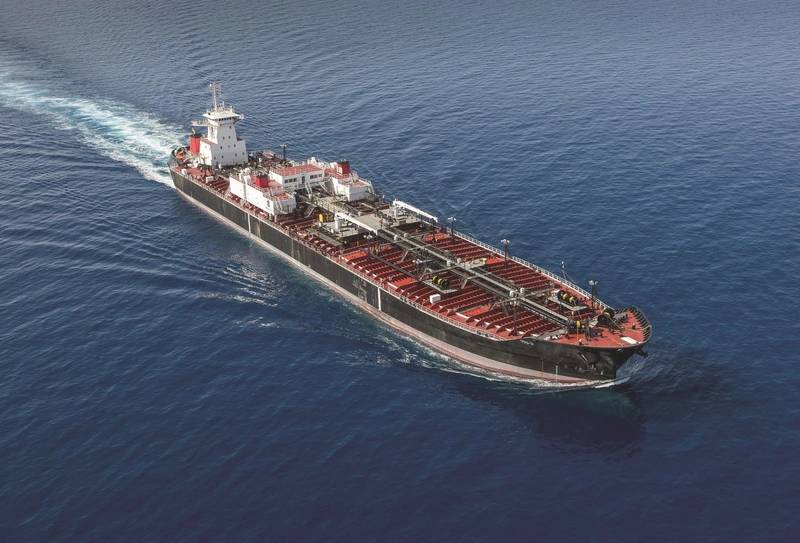 (Photo: Crowley)
(Photo: Crowley)
From the owners’ business side, the advantages of standardization are important. Capt. Rick Iuliucci, Vice President, Operations, at Vane Brothers, commented to Marine News about three ATBs delivered from Conrad Shipyard, during 2018 and into early 2019. These are the ATB tugs Assateague, Chincoteague and Wachapreague, partnered with three 80,000-barrel barges (the “800 Series” Doubleskin 801, 802 and 803).
Capt. Iuliucci stressed the importance of “sister” units: “The addition of these three ATB units to the Vane fleet has provided us the opportunity to support our customers’ requirements with enhanced safety and efficiency.”
In describing the three newbuilds, he says, “Each ATB has been built to the same specifications, enabling Vane to capitalize on standardization within the Assateague Class of vessel, and increasing our flexibility to respond rapidly to changes in the marketplace.”
ATB capabilities can also be the result of retrofit, Vane Brothers explains, “Along with the three Conrad units, Vane also recently received two ATB tugs from St. Johns Ship Building in Florida. The Jacksonville and Charleston are 4,200-horsepower Elizabeth Anne Class vessels that have been fitted with an innovative Beacon Finland JAK-400 Hydralok AT/B coupling system.” Towing winches (found on six other Vane tugs built at St. Johns) are removed when the tugs are configured for pusher capability.
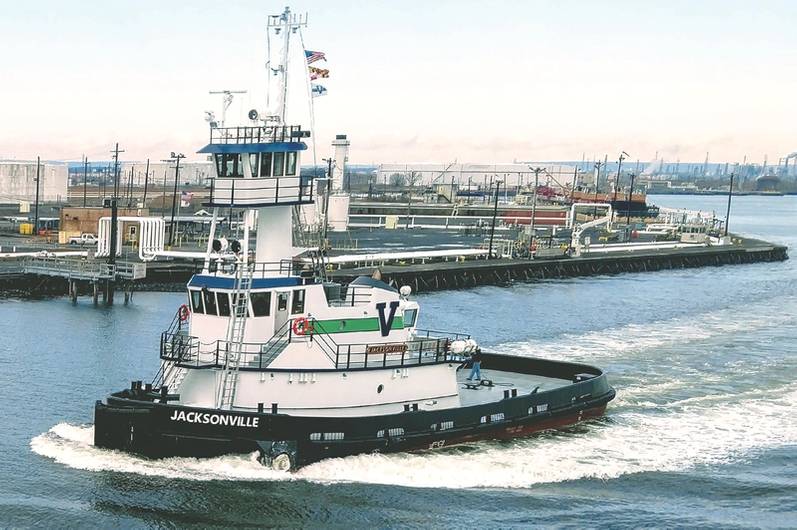 (Photo: Vane Bros.)
(Photo: Vane Bros.)
The newbuild tugs can work with existing barges that have been modified. Referring to the JAK-400, Vane says, “This system allows the ATB tugs to be securely linked to 50,000-barrel 500 series barges,” and explains further that two barges (both built in 2009) were modified as ATB barges at Lyon Shipyard in Virginia. “The success of our retrofit program has afforded us the ability to improve the operational performance of our existing fleet of Elizabeth Anne Class tugs and 50,000-barrel barges,” Captain Iuliucci says. “The recent addition of these tug/barge combinations has been well received by our customers, crews and regulators.”
The Vane Brothers fleet of 130 vessels also includes two ATBs (6,000-horsepower tugs – Brandywine and Christiana – and 144,000-barrel barges DS 141 and DS 143) that have been in service since 2007.
In the coastwise trades, privately held Crowley Maritime is a well-known name. Crowley says, “We maintain an extensive fleet ranging in size from 20,000 deadweight tons (DWT) to 45,800 DWT. This enables us to offer a wide range of transportation options to our petroleum and chemical customers.” Its ATBs range in size from 155,000 barrels (the “550” class) through 327,000 barrels (the “750” class). The larger units trade within the U.S. Gulf and play a vital role in bringing refined products into Florida, dominated by runs into Tampa, Port Everglades and Jacksonville (Crowley Maritime’s home base). Its medium sized ATBs are active in the U.S. Gulf and East Coasts, but also move products from refineries to terminals in the Pacific region. The “550” class ATBs ply routes along the West Coast.
Kirby Corporation, perhaps better known for its inland barge fleets, also operates ATBs, in the Gulf/Atlantic and along the Pacific coasts, with barge capacities reaching 185,000 barrels. Its recent newbuild Paul McLernan, linked to the barge Kirby 155-02, has been trading between ports in Texas and the southeastern U.S.
Moran Towing, based in Connecticut with locations around the U.S. Gulf and East Coast, operates a fleet of 10 ATBs in the products and easy chemicals trades. Its vessels include the tug Barbara Ann Carol Moran/barge Louisiana and Leigh Ann Moran/barge Mississippi. The tugs are 6,000 horsepower and 5,100 horsepower, respectively, with the barges capable of transporting 110,000 barrels of cargo. Its 5,100-horsepower tug Barney Turecamo pushes its barges regularly along Long Island Sound.
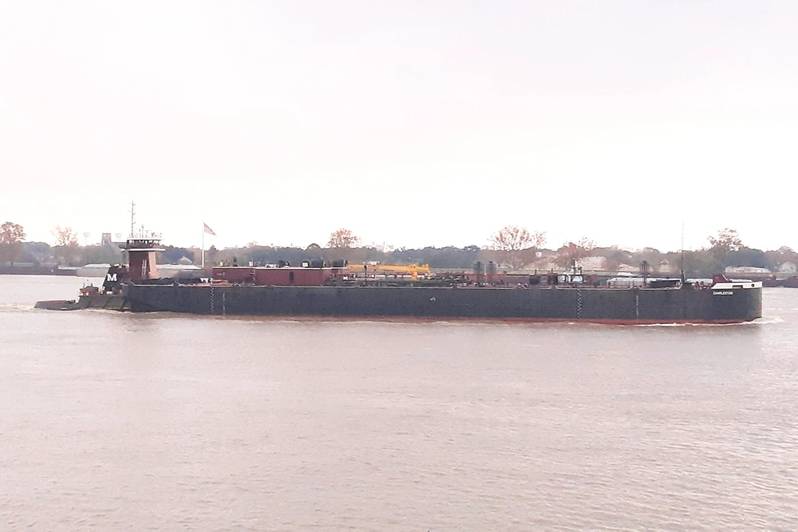 (Photo: Moran Towing)
(Photo: Moran Towing)
Overseas Shipholding Group (OSG), headquartered in Tampa, Fla., operates three ATBs in Jones Act trades (two just under 240,000 barrels, one of 346,000 barrels), one in Delaware Bay lightering service, tug OSG Horizon/ barge OSG351 (346,000 barrels) and has two barges (204,000 barrels) on order from the Gunderson Marine yard (now rebranded as Greenbrier Marine), on the West Coast, for delivery in 2020. OSG is a listed company, and its financial reports provide insights into earnings of ATBs. For the first nine months of 2019, its ATBs earned an average of $21,565 per day when working under contracts of affreightment, and $18,573 per day when working under spot chartering arrangements.
Reinauer, an East Coast mainstay (and owner of the Senesco shipyard in Rhode Island) also operates ATBs. In mid-2018, the yard delivered the Tier 4 tug Bert Reinauer (8,000 horsepower)/barge RTC-165 (150,000 barrels), which trades from refineries in Texas into receivers in Florida. Three other ATBs, Nicole Leigh Reinauer, Christian Reinauer and Meredith Reinauer, all 7,200 horsepower, are linked with 140,000- to 150,000-barrel barges, while its Dylan Cooper (4,000 horsepower) is mated with RTC 108 (100,000 barrels). Other ATB operators include Genesis Energy, active on inland and coastal waters, with two ATBs Genesis Eagle and Genesis Patriot, linked to 135,000-barrel barges trading in U.S. Atlantic waters. West Coast outfit Centerline Logistics (formerly Harley Marine Services), also operates several ATBs, with barges ranging up to 83,000 barrels, serving the Pacific Northwest as well as Alaskan waters.
The advantages of ATBs are applicable beyond coastwise oil trades. One need only look at the orderbook of Bay Shipbuilding (a unit of Italian shipbuilding group Fincantieri), in Sturgeon Bay, Wis. for evidence that ATBs are finding their way into other trades. In late summer 2019, NorthStar Marine (linked to Jax LNG, a smallscale liquefied natural gas (LNG) producer located in Jacksonville, Fla.) announced a deal with Bay Shipbuilding to build a 5,400-cubic-meter LNG barge, (with the possibility of building two sister barges) for transportation of LNG along the East Coast. In a statement, the yard said, “Utilizing a suitable tugboat, the barge will operate as an ATB that will initially run along the East Coast of the U.S. providing LNG bunkering solutions to NorthStar’s customers.”
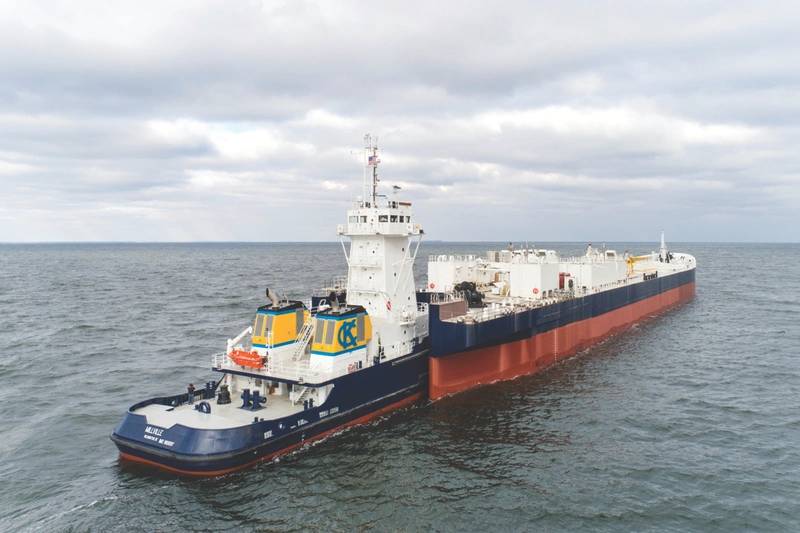 (Photo: Fincantieri)
(Photo: Fincantieri)
The yard’s CEO, Todd Thayse, told Marine News, “Entry into the U.S. LNG transportation vessel market has been a strategic interest of our organization. As domestic natural gas continues to rise, LNG has quickly become both a clean and competitively priced fuel alternative. More and more domestic industries are looking to LNG as their future fuel source, and we are extremely excited to be able to construct vessels that help our customers deliver LNG to parts of the United States in both an economical and safe manner.” He added, “Partnering with NorthStar and its affiliate companies on their latest project gives us the opportunity to be part of this exciting emerging industry and related market growth. The project draws upon the expertise of Fincantieri and allows us to bring our own designs to the LNG market.”
ATB configurations are being used elsewhere in the LNG realm. Q-LNG, a company owned by Harvey Gulf CEO Shane Guidry, is building the tug/barge combination Q- Ocean Service/Q-LNG 4000 (4,000 cubic meters), which will be delivered from VT Halter Marine in early 2020. The barge will be used for bunkering LNG fueled cruise and commercial vessels. According to the company, its trade will be “…commencing with a long-term contract with Shell Trading (U.S.) Company to deliver LNG as a fuel source to various ports in Florida and the Caribbean.” The yard has also been discussing a second, larger 8,000-cubic-meter barge with Q-LNG.
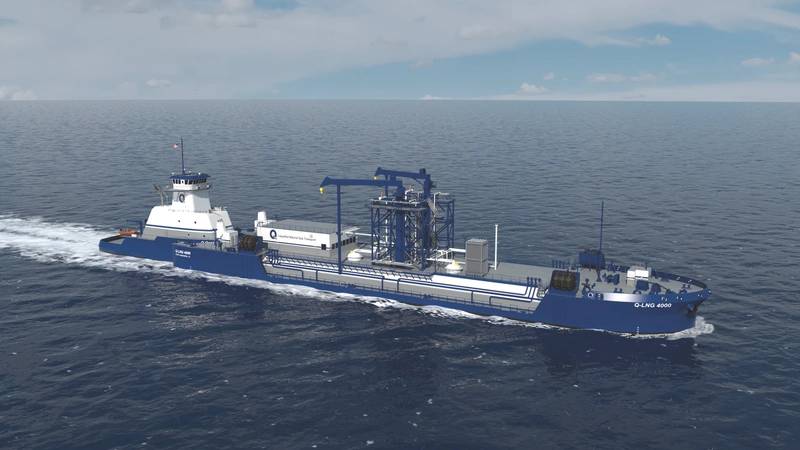 (Image: Q-LNG)
(Image: Q-LNG)
Historically, VT Halter, with its Pascagoula, Miss. location, has been very active building ATBs, including the 650 Class series for Crowley Maritime (10,500-horsepower tugs/178,000-barrel cargo capacity), for Bouchard Transportation, and a handful of units for OSG, including the vessels above.
Fincantieri’s Bay Shipbuilding has built ATBs for leaders in the petroleum trades. Recently, ATBs have been delivered to Kirby Corporation (6,000-horsepwer tugs and 155,000-barrel barges,) including Paul McLernan mentioned above. Moran Transportation has also built units at the yard, including the two mentioned earlier. In prior years, barges with 150,000-barrel capacity were delivered to U.S. Shipping Corp. (Petrochem Producer, Petrochem Trader, Petrochem Supplier). A new entrant to the transport arena is WAWA, the convenience mart chain, which uses its 2017-built tug Millville (8,000 horsepower)/ barge 1964 (185,000 barrels) to deliver gasoline from refineries in Texas to outlets in Florida.
Elsewhere on the Lakes, VanEnkevort Tug & Barge, Inc operates four ATBs, with tugs paired with barges trading drybulk raw materials around the Lakes. One unit, tug Joyce L. VanEnkevort, married to the self-unloading barge Great Lakes Trader, was built in 1998 by Bay Shipbuilding. The Sturgeon Bay yard is set to deliver an additional ATB, also with a self-unloading barge, to VanEnkevort in mid-2020.
ATBs have also provided a solution in the dredging business. Eastern Shipbuilding, in Panama City, Fla. delivered an ATB-configured trailing suction hopper dredge Ellis Island (mated with tug Douglas B. Mackie) to industry leader Great Lakes Dredge and Dock. In the coming years, we will likely see continued penetration of ATBs deep into the U.S. coastwise business, and potentially into markets abroad, as well, where the tug offers economic advantages compared to a ship.

















